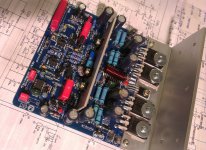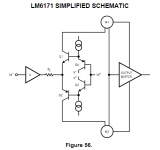Mainly how sensitive Id to Vgs is with temperature as the curves are very close at sane bias levels. A bit of loud music to warm things up and your quiescent goes all over the shop. I don't really want to bias the output to 0.5A per device!
You have to use properly designed bias spreader, I use bias of 130 mA per output pair and it's very stable. More explanation here. http://www.diyaudio.com/forums/solid-state/243481-200w-mosfet-cfa-amp.html
By balanced I mean symmetrical or complimentary. Input is single ended - feedback into the other side of the input stage. Truly balanced complementary designs probably best with VFA as with with CFA you have a lo z -input node to deal with.
🙂
OR, you could do as DADOD does and put a buffer (Z converter) on the (-) input.... now both inputs have same high Z and still operates as a CFA.
THx-RNMarsh
Scott as usual just can't communicate. Look at the cite and I think you will find what I thought was humorous.
Sorry Ed I read a different headline reminds me of the time I emailed a friend from Pittsburgh and told him my son is going to CMU and he said "what's that".
Sorry Ed I read a different headline reminds me of the time I emailed a friend from Pittsburgh and told him my son is going to CMU and he said "what's that".
And how did he do at Central Methodist University? 🙂
I don't get it, servo and power supply regulator(cap multiplier?) not balanced?
This is a balanced input to unbalanced symmetrical complementary power amp output. CMRR is quite good.
I was pulling your leg, successfully it appears 😉
But the design is first rate as far as I can see.
Jan
I was pulling your leg, successfully it appears 😉
But the design is first rate as far as I can see.
Jan
😀
And how did he do at Central Methodist University? 🙂
He ended up transferring to Wesleyan, BTW my niece does the web site and publicity at the Warhol Museum.
One very true balanced CFA power amp from input to output , with balanced in and balanced out , or with SE in and balanced out , developed by our member Polyphase .
http://www.diyaudio.com/forums/solid-state/270239-i-call-infinitron.html
http://www.diyaudio.com/forums/solid-state/270239-i-call-infinitron.html
This might be of interest to Warhol fans.
http://www.earthcam.com/usa/pennsylvania/pittsburgh/warhol/index.php?cam=warhol_figmentstream
EarthCam - Warhol Cam
http://www.earthcam.com/usa/pennsylvania/pittsburgh/warhol/index.php?cam=warhol_figmentstream
EarthCam - Warhol Cam
Have you built that (post 80816) , Dadod ?
I had a similar one (infidel). It worked , had perfect 250khz+ square
waves ..... but was very touchy in the thermals.
I deemed it a failure , fell back on more "tame" designs (diminishing
returns decision - too many parts).
A design such as this would be a good candidate for smd. Looks like all
up to Q6/8 are @1ma - nice dual sot23-6 pairs.
OS
I had a similar one (infidel). It worked , had perfect 250khz+ square
waves ..... but was very touchy in the thermals.
I deemed it a failure , fell back on more "tame" designs (diminishing
returns decision - too many parts).
A design such as this would be a good candidate for smd. Looks like all
up to Q6/8 are @1ma - nice dual sot23-6 pairs.
OS
Have you built that (post 80816) , Dadod ?
I had a similar one (infidel). It worked , had perfect 250khz+ square
waves ..... but was very touchy in the thermals.
I deemed it a failure , fell back on more "tame" designs (diminishing
returns decision - too many parts).
A design such as this would be a good candidate for smd. Looks like all
up to Q6/8 are @1ma - nice dual sot23-6 pairs.
OS
No, not yet, just unbalanced version without buffers at -in, a CFA.
It is really a good candidate for SMD and I don't see any thermal problem as the VAS and OPS are the same.
I never did any SMD layout (at least not complicate as this one), but I think, I have to start with IPS, VAS and OPS will stay THT.
Attachments
Last edited:
I find the "balanced" circuitry suddenly stopping before the output a odd place to stop - why not fully duplicated outputs to continue the "symmetry"
Nelson's SuSy is far more "balanced" even when implemented with same polarity devices
Nelson's SuSy is far more "balanced" even when implemented with same polarity devices
He ended up transferring to Wesleyan, BTW my niece does the web site and publicity at the Warhol Museum.
I can't decide if a Warhol museum is the last thing he would have wanted or not...
OR, you could do as DADOD does and put a buffer (Z converter) on the (-) input.... now both inputs have same high Z and still operates as a CFA.
THx-RNMarsh
I am a reductionist by nature and avoid complexity if I can.
Separately I agree that buffering the - input on a CFA still leaves one with an amplifier that behaves like a CFA. However, as we have seen its not viewed like that . . . and I don't want to open that can of worms again.
🙂
Separately I agree that buffering the - input on a CFA still leaves one with an amplifier that behaves like a CFA. However, as we have seen its not viewed like that . . . and I don't want to open that can of worms again.
Good idea, because it does not. That's according to your own criteria, and also according with e.g. the LM6171 data sheet.
LM6171 TI data sheet said:The LM6171 is a true voltage feedback amplifier. Unlike current feedback amplifiers (CFAs) with a low inverting input impedance and a high non-inverting input impedance, both inputs of voltage feedback amplifiers (VFAs) have high impedance nodes. The low impedance inverting input in CFAs will couple with feedback capacitor and cause oscillation. As a result, CFAs cannot be used in traditional op amp circuits such as photodiode amplifiers, I-to-V converters and integrators.
Attachments
Last edited:
Natural facts -
Waly; You are reading Marketing spin to the old guys who cannot get their heads around a CFA.
All CFA with a buffered (-) input are now being called a VFA so they don't scare off the old time app engineers.
Personally, I prefer simpler also... .
THx-RNMarsh
Good idea, because it does not. That's according to your own criteria, and also according with e.g. the LM6171 data sheet.
Waly; You are reading Marketing spin to the old guys who cannot get their heads around a CFA.
All CFA with a buffered (-) input are now being called a VFA so they don't scare off the old time app engineers.
Personally, I prefer simpler also... .
THx-RNMarsh
All CFA with a buffered (-) input are now being called a VFA
THx-RNMarsh
But they are, just like an H-bridge input. Youse guys have to dummy up a little here. Waly is right buffered input CFA's behave just like VFA's input gm becomes fixed.
Last edited:
No, not yet, just unbalanced version without buffers at -in, a CFA.
It is really a good candidate for SMD and I don't see any thermal problem as the VAS and OPS are the same.
I never did any SMD layout (at least not complicate as this one), but I think, I have to start with IPS, VAS and OPS will stay THT.
I had the privilege to listen and test this prototype amplifier. It was very stable under varying loads and output levels. And, it tests exceptionally good. same for its sound with both electrostatics and dynamic speaker types. ---- all without the extra VFA simulator/converter on the (-) input.
I wouldn't add the extra complexity unless there was some compelling need for a balanced input Z for a signal source.
I have never found such inputs needed for best sound/performance in a home audio environment. But sometimes there is a compelling audiophile Marketing need.
THx-RNMarsh
Last edited:
But they are, just like an H-bridge input. Youse guys have to dummy up a little here. Waly is right buffered input CFA's behave just like VFA's input gm becomes fixed.
Externally, yes. And for app engineers, yes. It wont matter much to them. But internally, the window of operational parameters, are still CFA. Unless, of course we redefine for simplicity sake that only the Z of the inputs ports defines a CFA or VFA..... which many are also trying to do.
THx-RNMarsh
Last edited:
- Status
- Not open for further replies.
- Home
- Member Areas
- The Lounge
- John Curl's Blowtorch preamplifier part II

